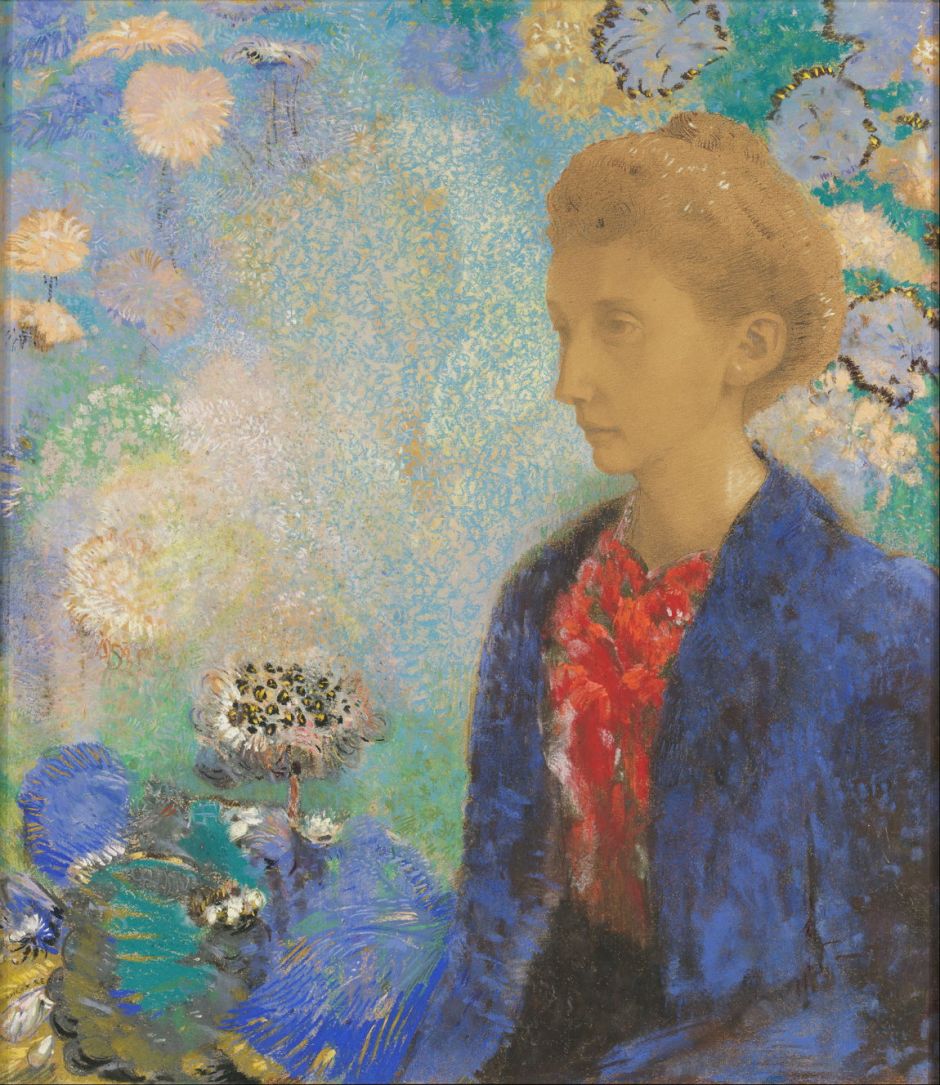Painting in pastels is as close as you can come to pure pigment, thus to pure colour. This week’s pastellist is perhaps the greatest exponent of this. Odilon Redon (1840–1916), who is known by his nickname acquired from his mother, Marie-Odile, didn’t turn to pastels until the middle of his career.
He tried to start with a classical training, but couldn’t gain admission to the École des Beaux-Arts in Paris, and didn’t stay long as a pupil in Jean-Léon Gérôme’s studio. He concentrated on etching and lithography during his early career, then turned to painting in oils. It wasn’t until the 1890s, when he was in his fifties, that Redon concentrated on painting. For the next twenty years he produced a series of highly original paintings in oils and pastels.

Oedipus and the Sphinx had been one of the major stories depicted in paint during the nineteenth century, with significant paintings by JAD Ingres, Gustave Moreau and others. Redon took the Sphinx into a mediaeval court in this pastel painting of Mystical Knight from 1894, which must remain one of its most original treatments. Oedipus is carrying a disembodied head in his right arm as he out-stares the Sphinx.

Two Women in a Landscape, The Three Colours from about 1895 is another unusual painting in chalk and pastel from about the same time. Two women – one apparently white, the other black – stand, their robes coloured by the tricolore.
These two early works followed the late nineteenth century style in which pastels are applied in linear strokes, giving texture to their colour.

For some of the portraits Redon painted at this time, he also made more radical and imaginative pastel versions, here Baronne de Domecy (c 1900), with its huge imaginary flowers. He was the lifelong friend of Armand Clavaud, an eminent botanist of the day, who must have found Redon’s paintings a revelation.

It has been proposed that Redon’s pastel Profil sur méandres rouges (Profile on Red Meanderings) (c 1900) was intended to portray Joan of Arc, the French saint and hero.

In the early years of the twentieth century, Redon became one of a great many artists to paint Shakespeare’s Ophelia (1900-5) from the tragedy of Hamlet. He shows her in a lily pond, presumably just after her suicide. The contrast between this and (for example) JW Waterhouse’s paintings of Ophelia from 1889-1910 couldn’t be more stark.

Flower Clouds (c 1903) is a pastel introducing another theme which recurs in Redon’s paintings, a sailing boat containing people. In this version, it’s set against a riot of colourful flowers in the sky.

The Large Window, from 1904, is one of the most remarkable pastel paintings that I have seen. Framed by carved masonry shown in the dull greys of charcoal, a mediaeval stained glass window dazzles with its bright, rich colours, the pure pigment of pastel at its best.

Like the avant garde American artist Charles Demuth, Redon also painted a succession of more conventional floral still lifes, such as his Vase of Flowers, from the period 1900-10. In Demuth’s case, these appeared to be therapeutic to him when he was suffering the consequences of his diabetes. I don’t know why Redon painted his.

The Yellow Sail (c 1905) is one of Redon’s best-known paintings, and follows on with the sailing boat theme from Flower Clouds. It’s best-developed here: the small boat with its distinct ochre sail is filled with brilliant, twinkling jewels. Two women sit at its stern, one with her hands on the tiller. The sea isn’t calm though, and small waves break by the boat, while the sky is full of scud clouds.

Buddha (1906-7), one of Redon’s wonderful pastels in the collection of the Musée d’Orsay, revisits the Buddha theme in its best-known form, with the figure of Buddha stood near the tree, and a weird collection of plants around them.

La coquille (The Seashell) (1912) is another exceptional pastel painting, here an aquatic still life.
In 1913, Redon’s paintings were included in the large and highly influential exhibition of modern art in New York referred to as the Armory Show, which kickstarted modernism in America.
I also have two rather special works for which I’ve not discovered a date.

Pandora is one of a series of works in which he examined this well-known myth, a parallel to Eve and the Fall of Man in Judeo-Christian mythology. Pandora was the first human woman created by the gods, and as punishment for the theft of fire by Prometheus, she was moulded from earth and equipped with seductive gifts.
She was provided with a jar (which was later corrupted to become a box) which contained toil, sickness, and diseases. When Pandora was given to Epimetheus as a gift from Zeus, she opened the jar and scattered its contents – ending the ‘golden age’ of mankind. The one item which remained trapped inside the jar was Hope.
Redon’s pastel painting, now in Houston, shows her clutching the box to her bosom, in a garden full of huge and colourful flowers.

Evocation, also known as The Head of Christ, or Inspiration from a Mosaic in Ravenna, may well have been inspired by a mosaic which he saw in Ravenna, Italy, showing this motif. His eyes are closed, and around him are strangely fascinating forms, painted in brilliant colours: a piercingly blue tree, perhaps, and others which coalesce in the imagination.
Odilon Redon died in Paris in 1916, during the First World War. Tragically, his innovative art was quickly overshadowed by the moderns, but his images have gone on to inspire other artists of the twentieth century. And, like those of Blake, they will remain radical, fresh, and inspiring, particularly his pastels.

